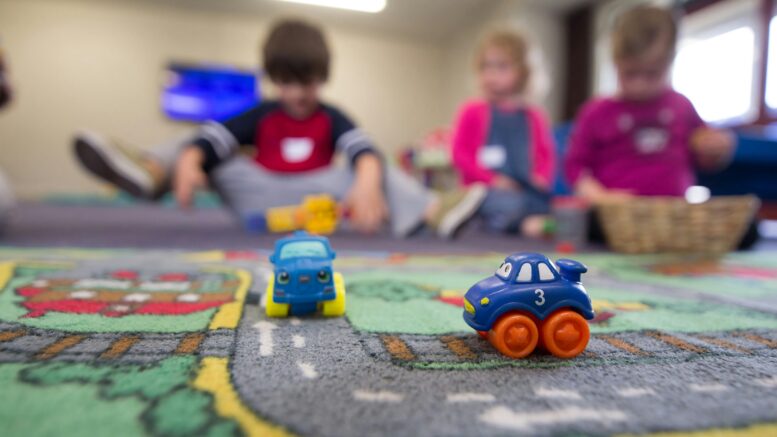Special Survey of New York State Childcare Providers
- Facing Staffing & Financial Challenges, Majority Satisfied with the Care & Educational Contributions They Give NY’s Children
- Nearly Half of All Childcare Providers Say COVID Will Have Long-Term Impacts on Children
- Call for Increasing Early Childhood Educational Funding, Predict Added Resources Would Improve Outcomes for Children & State
Crosstabs Press Release Presentation
Loudonville, NY. Majorities of New York’s childcare providers are challenged to recruit, train, and retain staff as well as to make ends meet according to a new Siena College Research Institute (SCRI) survey of New York State childcare providers conducted as part of student class in partnership with the Early Care and Learning Council (ECLC). Despite those challenges, most of the 842 providers surveyed give themselves high grades for the care that they provide children as well as for their contribution to early childhood education.
When asked to look forward from the pandemic, 30% say that children bounce back easily and as things get back on track children will too, but a plurality, 48% say that the impact of COVID-19 on children will have long lasting effects that we will see for years. Ninety-two percent support governmental efforts aimed at generating more financial resources for early childhood education. Large majorities of providers think more funds dedicated to early childhood education would result in children being more prepared for and being more successful in school, fewer childhood mental health issues, a more robust state workforce as well as reductions in crime and drug abuse.
“Why do they get into this field? The single dominant reason according to nearly two of every three providers is – ‘love of children.’ Few said it was for the money. It’s challenging – long hours, difficulties getting and keeping good staff and trying to cover expenses – but working with kids makes it all worthwhile is what most told us,” according to Don Levy, SCRI’s Director.
The Challenges Providers Face
Sixty-four percent say that maintaining required staffing levels are either a great deal of a challenge (40%) or somewhat of a challenge (24%). Similarly, 66% are challenged by recruiting qualified staff and 56% by retaining staff. Sixty-one percent are challenged by providing their staff with benefits and maintaining staff morale is a challenge for 52%. And importantly, 53% report being challenged by providing staff training.
Sixty-nine percent say that making a profit poses a challenge for them. Being profitable is somewhat more of a challenge for family care providers at 74% as compared to childcare centers at 66%. Providing adequate space is a challenge for over half (55%). Fewer are challenged by having enough books, toys and games (45%), maintaining attendance sheets (38%) and providing nutritious meals (38%). A majority (52%) say that filling all the slots available is a challenge.
“Running the business of an early childhood center is difficult. Staffing, every aspect of staffing from recruiting to paying for training, is demanding for providers. While fewer struggle to provides books, meals and essentials, those everyday needs still weigh on providers. And perhaps consequentially, half say that they struggle to balance their dual functions of attending to the needs of educating children,” Levy said.
Caring and Educating Children
Twenty-one percent of providers, 9% of childcare centers and 27% of family child care providers, say that while they try to stimulate and teach the children, when it really comes down to it, they are a safe place that lovingly takes care of children but not really a school. Far more, 63% say that their program not only cares for children but thoughtfully seeks to educate and develop them as young people preparing for life.
When asked how satisfied they are with their level of service, providers overwhelmingly grade themselves very high on aspects of taking care of children but not all are fully satisfied with the job they are doing to develop and educate young students. Over 90% are somewhat or completely satisfied with maintaining a clean environment and having clear and consistent safety measures, but while 91% are satisfied with the degree they offer opportunity for social skill development, fewer, albeit a large majority, have and follow a structured curriculum plan for all children (80%) or develop for each child an individual learning plan (64%).
COVID’s Impact
Forty-eight percent of providers believe the impact of COVID-19 will have long lasting effects we will see for years, while 30% are more inclined to say that children bounce back easily, as things get back on track, children will too. Child care center leaders at 55% are more inclined than family setting providers, 43%, to think that the pandemic will have long lasting effects.
Still, at least 60% of all providers are somewhat or very concerned about each of the following as we move forward from the pandemic: shortened attention span, language development, social skills, mental health, retention of information and separation anxiety.
“Despite 30% of providers thinking kids will bounce back from COVID, the list of potential learning, social skill and mental health difficulties on the horizon are troubling according to a majority of providers. They say that coming out of the pandemic will be difficult for the children they serve,” Levy said.
Financial Resources and Future of New York’s Kids
Ninety-two percent of providers strongly (77%) or somewhat (15%) support governmental efforts aimed at generating more financial resources for early childhood education. Nearly as many, 84% support expanding child care assistance eligibility to families that make up to 85% of the state median income and 83% support offering tax credits for employer provided or sponsored child care. Fewer, but a majority of 57%, support imposing a payroll tax on certain employers for the purpose of enhancing early childhood education for children under five years of age.
“While the providers say that they would use increased funding to increase staff pay, purchase equipment, make facility improvements, and enhance the education of children, they point to significant long-term societal improvements that they believe increased funding for early childhood education would yield,” Levy said.
Eighty-four percent say it would be somewhat or very likely that more children would be prepared to perform in kindergarten. Similarly, 82% predict that increased funding would lead to children having a better educational experience in K-12.
“Seventy to eighty percent of providers predict that spending more on early childhood education would result in fewer young people experiencing mental health issues, New York State would have a more robust workforce, and we would see reductions in crime and addiction. Our childcare providers are calling loud and clear for additional investment in early childhood education and they believe that investment will go a long way to not only helping children but in addressing many of our current social problems,” Levy said.





